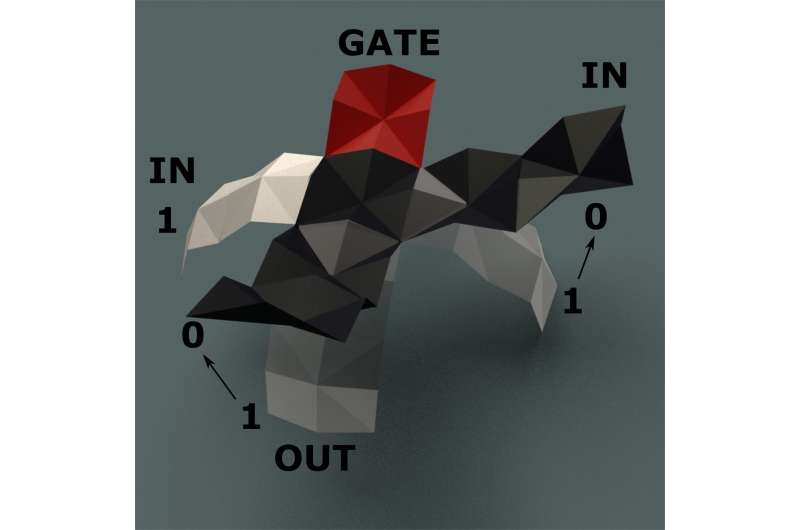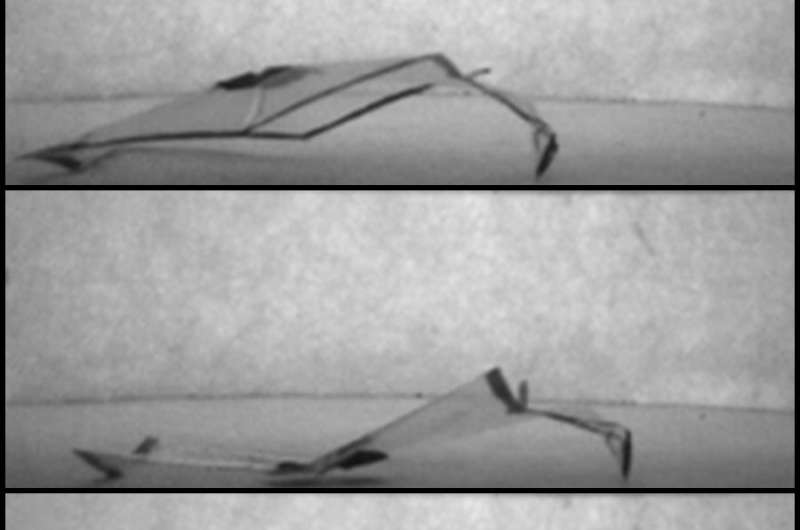June 20, 2018 report
Soft robots utilize humidity gradient levels to generate signals

A team of researchers at the U.S. Air Force Research Laboratory, Wright-Patterson Air Force Base, has developed a type of soft robot that can generate signals without using electricity. In their paper published in Proceedings of the National Academy of Sciences, the researchers describe their study of origami objects and their possible use as signaling devices and possibly as logic gates.
Origami is, of course, the art of folding paper into interesting objects. In this new effort, the researchers looked to the ancient art form as a possible building block for a soft robot. Instead of using paper, the team used sheets of polypropylene—it can absorb water from atmospheric humidity without losing its main form. It does lose some of its stiffness, however, when put into a humid environment. The researchers exploited that phenomenon to use such sheets as mechanical actuators.
They found that if they bent the sheets in certain places, the sheet would flatten when exposed to humid conditions. Conversely, the sheets would rise once again when exposed to drier air. This ability to move between states, the researchers noted, allowed the sheets to serve as a trigger for actions by other types of devices or machines. It also allowed for the generation of signals using only environmental conditions—based on the way the polypropylene behaved over a humidity gradient. And under the right conditions, the sheets could exist in two states, flat or upright, suggesting their use as logic gates.

In testing their ideas, the researchers found that when joining several sheets together, they could share information, carry out Boolean logic and even move around. This, they claim, suggests their use in wide variety of soft-robot applications, some of which might include carrying out functions normally done by digitally based machines.
Soft robotics is a promising field due to some of the expected benefits. Such robots would be better, it is believed, at handling delicate objects. Soft robots that could carry out tasks automatically are expected to offer services such as signaling air conditioning systems or manipulating objects based on nothing but humidity levels.
More information: Benjamin Treml et al. Origami mechanologic, Proceedings of the National Academy of Sciences (2018). DOI: 10.1073/pnas.1805122115
Abstract
Robots autonomously interact with their environment through a continual sense–decide–respond control loop. Most commonly, the decide step occurs in a central processing unit; however, the stiffness mismatch between rigid electronics and the compliant bodies of soft robots can impede integration of these systems. We develop a framework for programmable mechanical computation embedded into the structure of soft robots that can augment conventional digital electronic control schemes. Using an origami waterbomb as an experimental platform, we demonstrate a 1-bit mechanical storage device that writes, erases, and rewrites itself in response to a time-varying environmental signal. Further, we show that mechanical coupling between connected origami units can be used to program the behavior of a mechanical bit, produce logic gates such as AND, OR, and three input majority gates, and transmit signals between mechanologic gates. Embedded mechanologic provides a route to add autonomy and intelligence in soft robots and machines.
© 2018 Tech Xplore



















